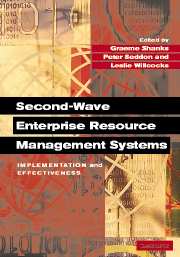Book contents
- Frontmatter
- Contents
- List of Contributors
- Introduction: ERP – The Quiet Revolution?
- Part I Implementation and Effectiveness: Overview
- 1 Learning from Adopters' Experiences with ERP: Problems Encountered and Success Achieved
- 2 Innovating with Packaged Business Software: Towards an Assessment
- 3 A Comprehensive Framework for Assessing and Managing the Benefits of Enterprise Systems: The Business Manager's Perspective
- 4 The Continuing ERP Revolution: Sustainable Lessons, New Modes of Delivery
- Part II From Risks to Critical Success Factors
- Part III From Learning to Knowledge
- Part IV Cultural Aspects of Enterprise Systems
- Part V Future Directions
- Index
- References
3 - A Comprehensive Framework for Assessing and Managing the Benefits of Enterprise Systems: The Business Manager's Perspective
from Part I - Implementation and Effectiveness: Overview
Published online by Cambridge University Press: 05 February 2012
- Frontmatter
- Contents
- List of Contributors
- Introduction: ERP – The Quiet Revolution?
- Part I Implementation and Effectiveness: Overview
- 1 Learning from Adopters' Experiences with ERP: Problems Encountered and Success Achieved
- 2 Innovating with Packaged Business Software: Towards an Assessment
- 3 A Comprehensive Framework for Assessing and Managing the Benefits of Enterprise Systems: The Business Manager's Perspective
- 4 The Continuing ERP Revolution: Sustainable Lessons, New Modes of Delivery
- Part II From Risks to Critical Success Factors
- Part III From Learning to Knowledge
- Part IV Cultural Aspects of Enterprise Systems
- Part V Future Directions
- Index
- References
Summary
Introduction
According to AMR Research, total revenue in the enterprise application and services market in 1999 was US$18.3bn. (Gilbert, 2000). Enterprise application software implementation costs are often reported to be five to ten times the cost of software licenses (Davenport, 2000). If so, organizations worldwide spent something like US$90–180bn. on enterprise systems in 1999. Most organizations that have implemented enterprise systems expect to continue using them for many years.
Enterprise systems are integrated, enterprise-wide, packaged software applications that impound deep knowledge of business practices accumulated from vendor implementations in many organizations. Today, enterprise systems are evolving to incorporate new technologies, such as e-commerce and the internet, data warehousing, and customer relationship management. Enterprise software is a semi-finished product with tables and parameters that user organizations and their implementation partners configure to their business needs. Implementation of enterprise systems therefore involves both business and IT managers who work together to define new operational and managerial processes.
The question we ask in this chapter is as follows: If organizations around the world spent US$100bn. or more on enterprise systems in 1999, what sorts of benefits did they, or can they, achieve? To answer this question, we present a comprehensive framework of benefits that organizations may be able to achieve from their use of enterprise systems. Our focus is on business benefits only, not on costs. Our framework establishes a base for managing the implementation and operation of enterprise systems.
- Type
- Chapter
- Information
- Second-Wave Enterprise Resource Planning SystemsImplementing for Effectiveness, pp. 74 - 101Publisher: Cambridge University PressPrint publication year: 2003
References
- 11
- Cited by



